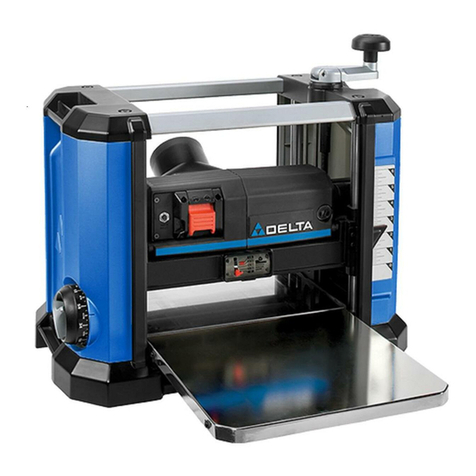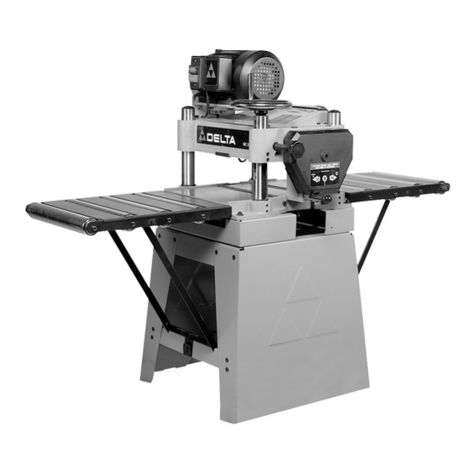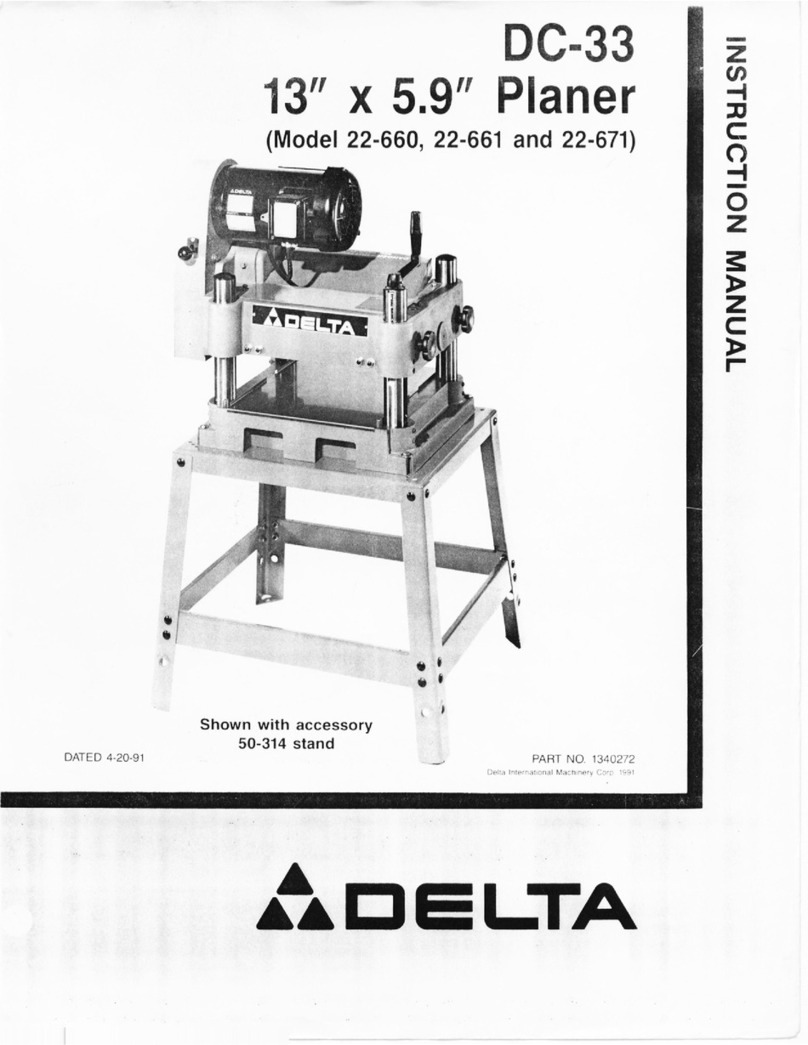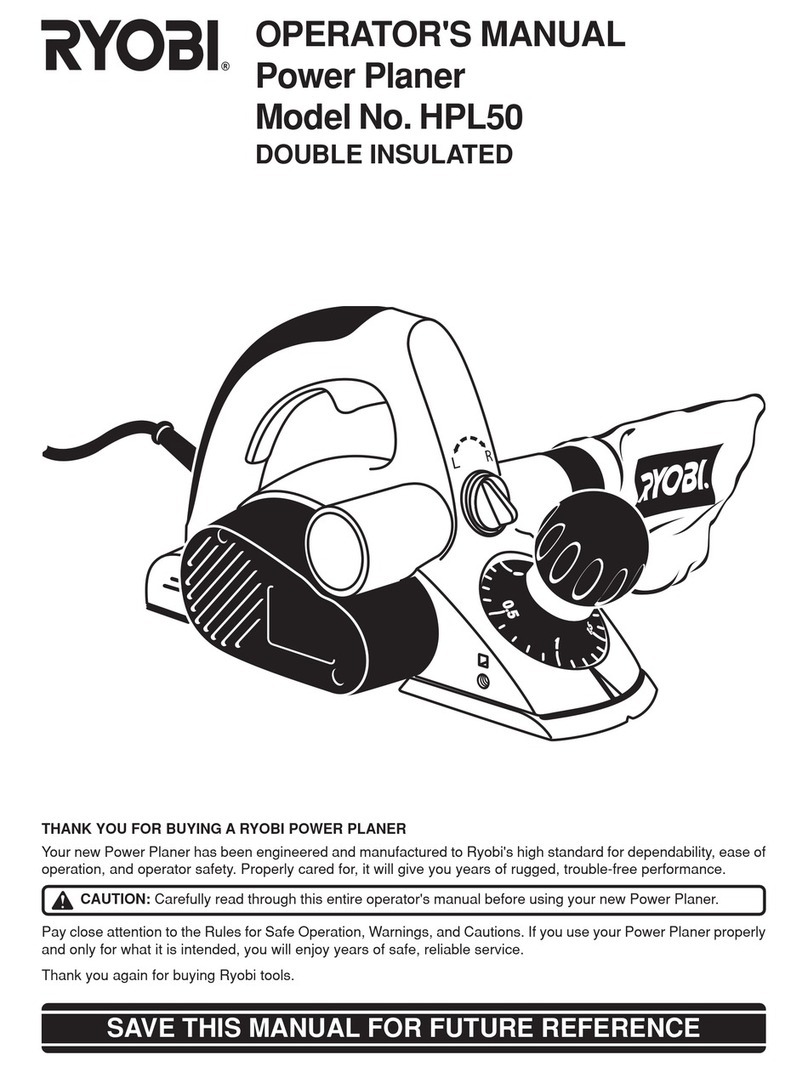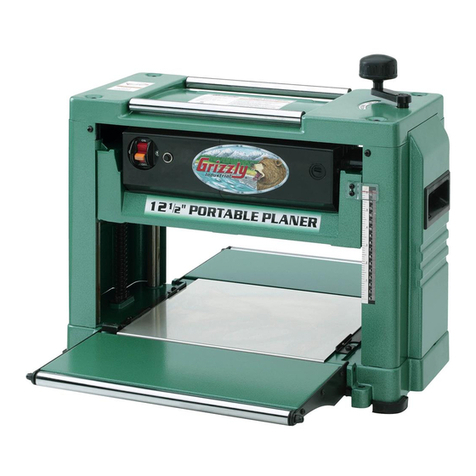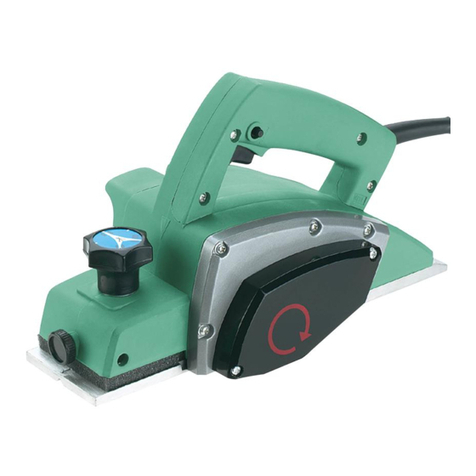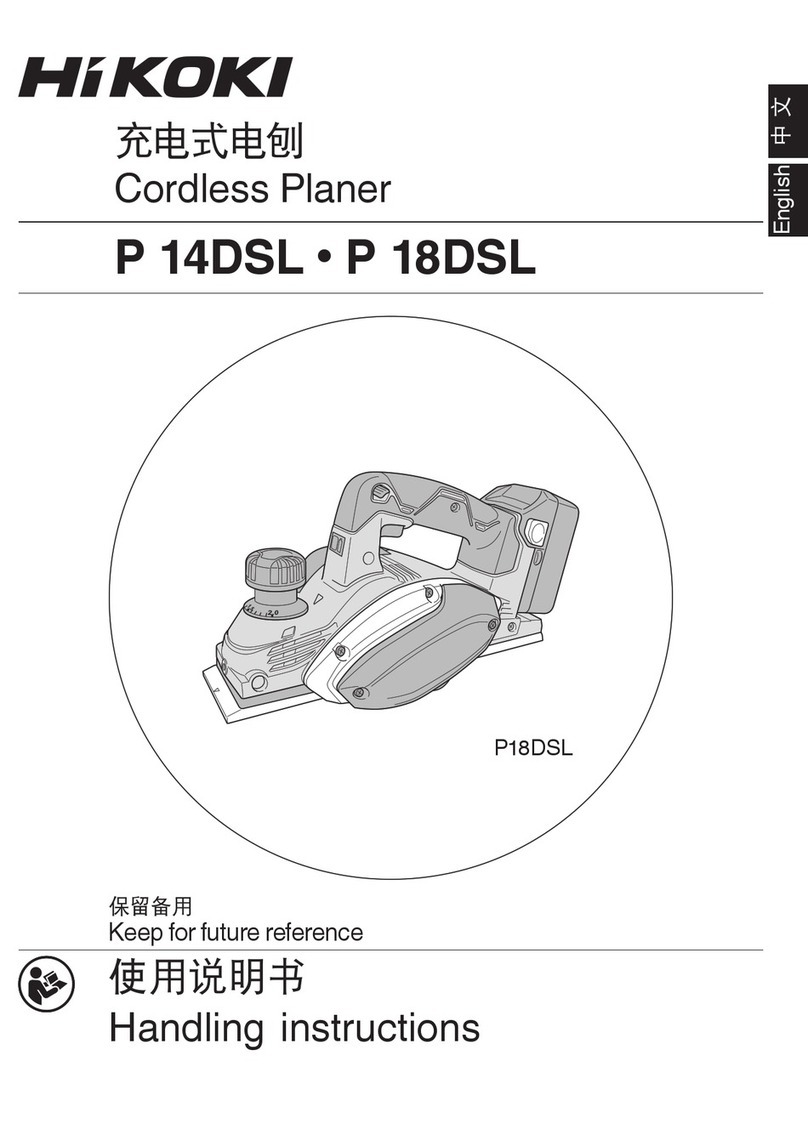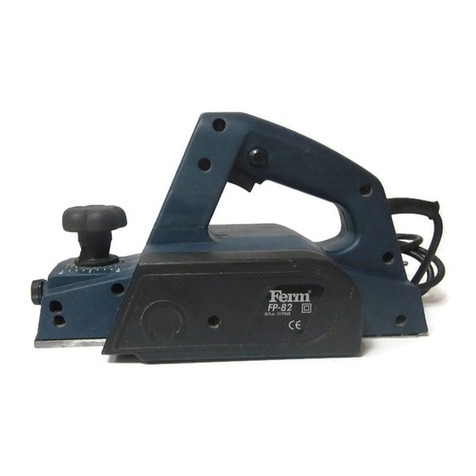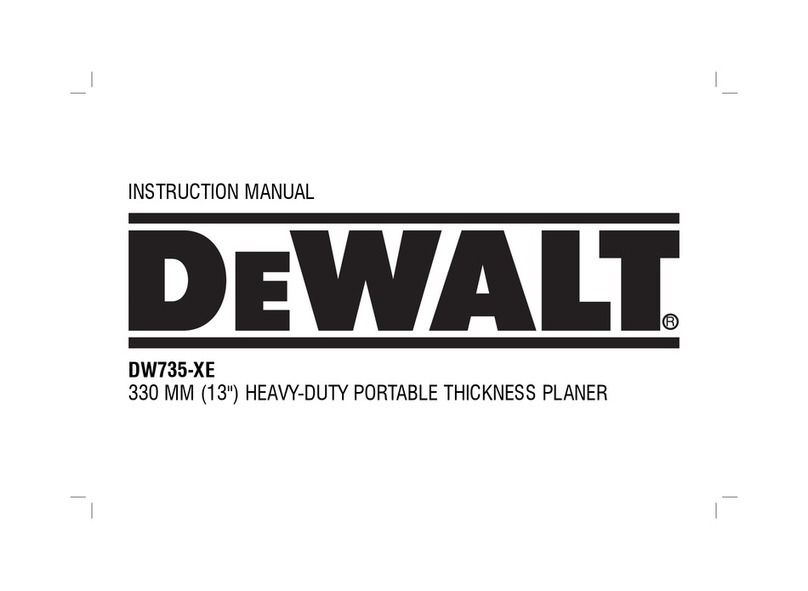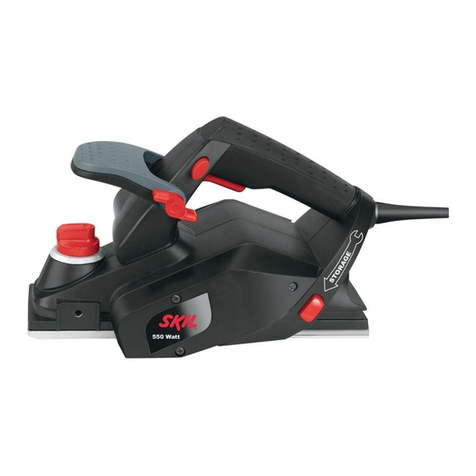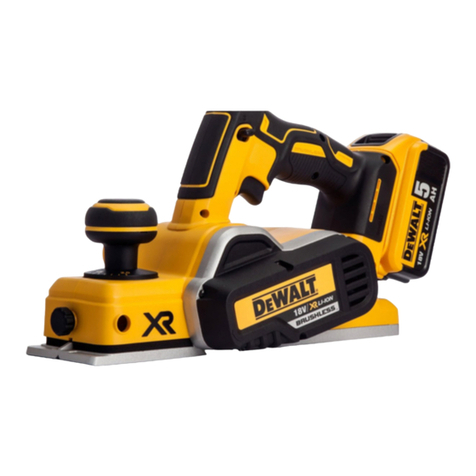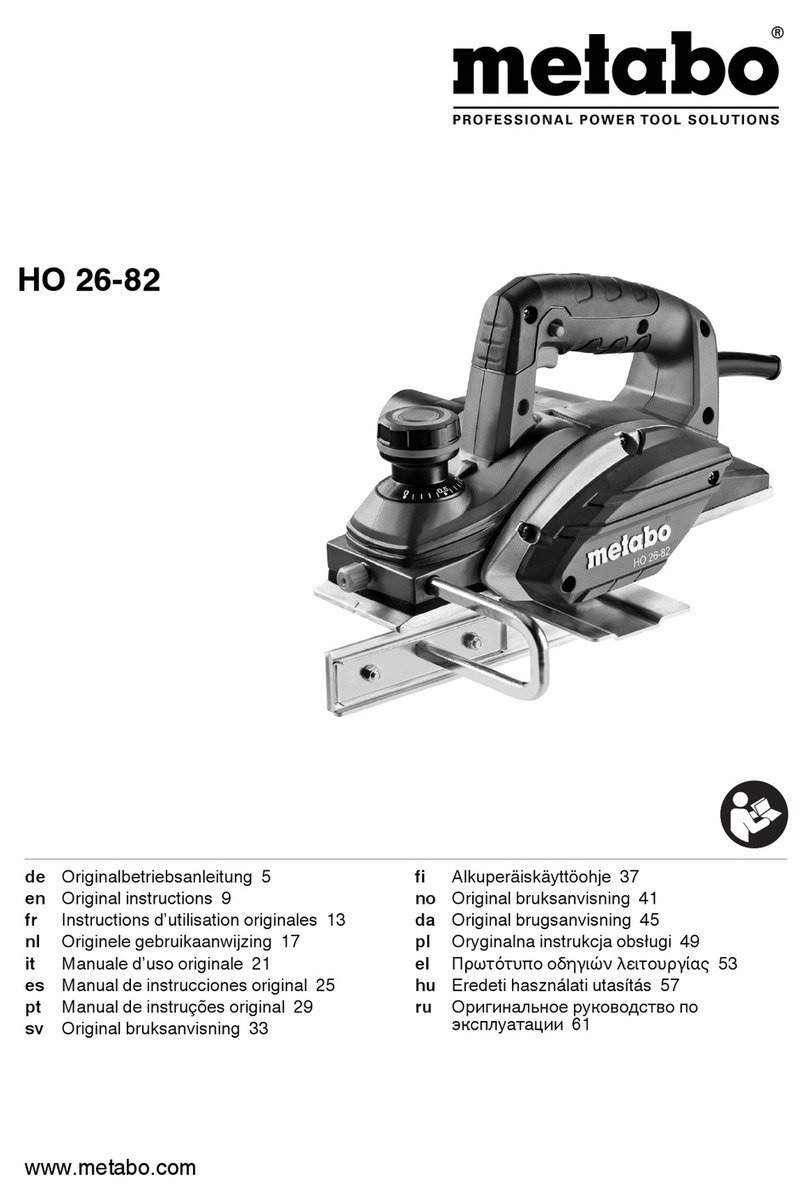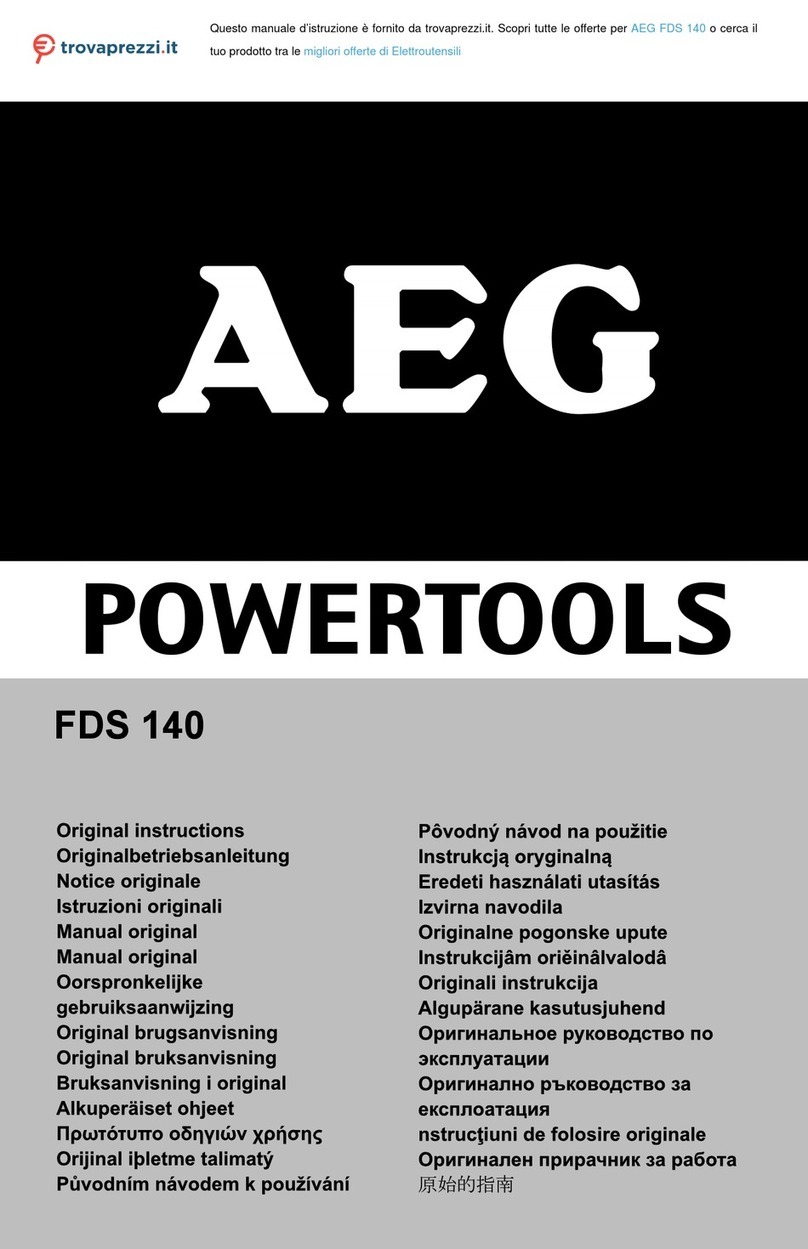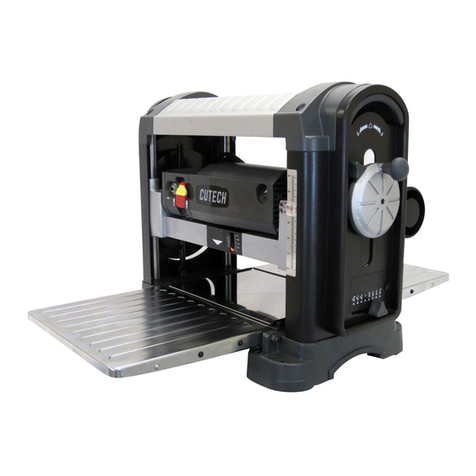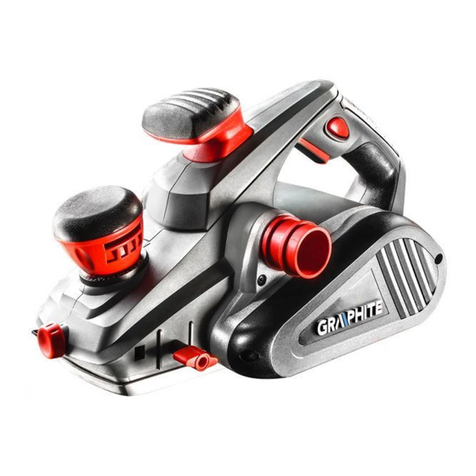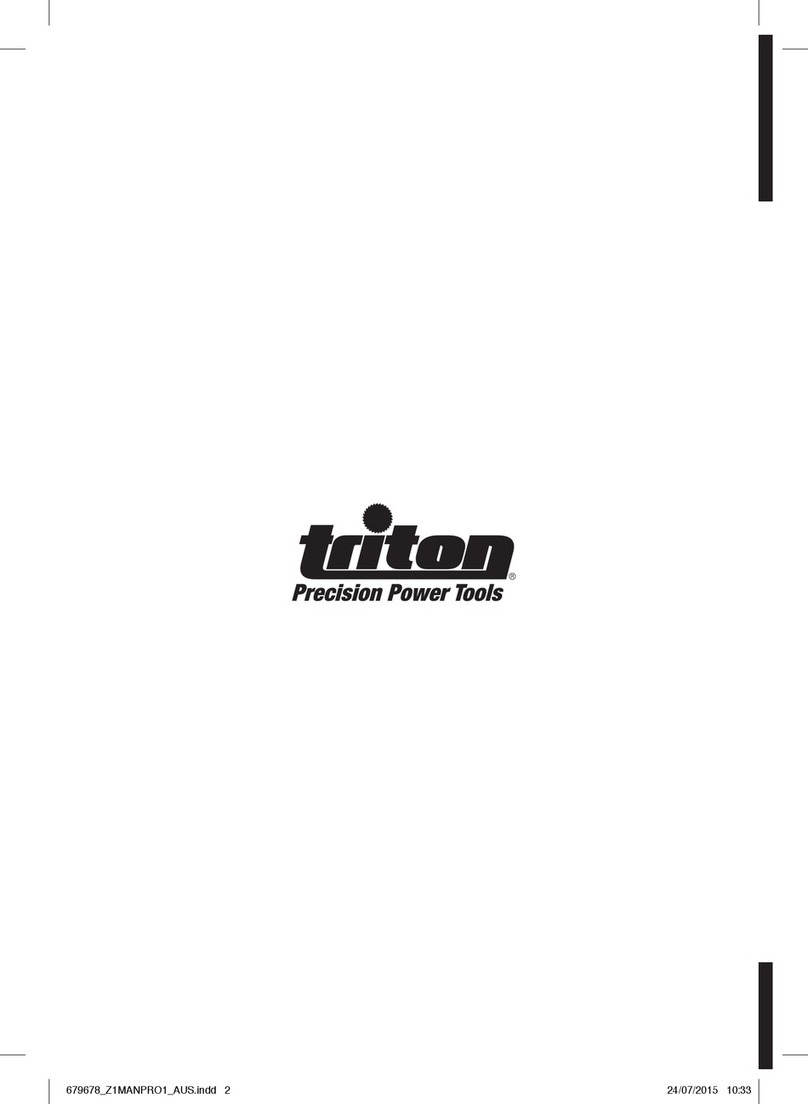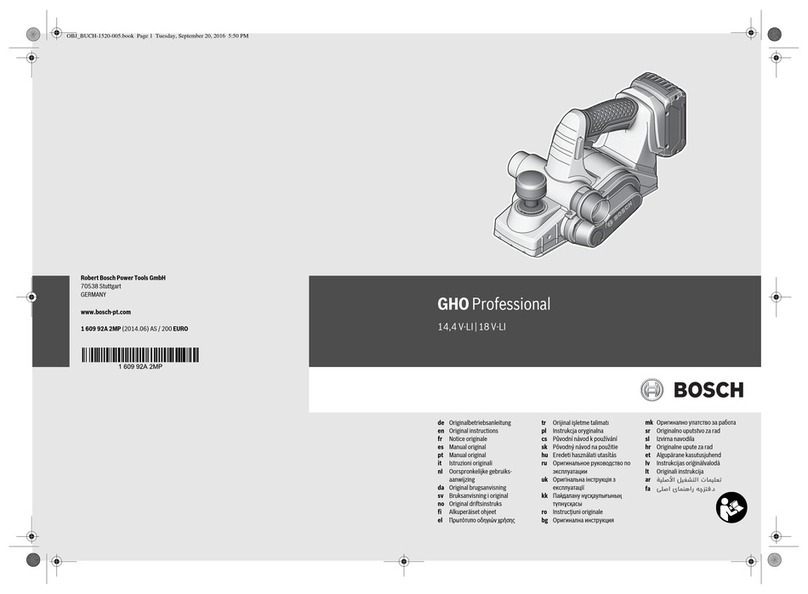Delta ShopMaster TP300 User manual

INSTRUCTION MANUAL
12" Portable Planer
(Model TP300)
PART NO. 909543 - 01-02-03
Copyright © 2003 Delta Machinery
To learn more about DELTA MACHINERY
visit our website at: www.deltamachinery.com.
For Parts, Service, Warranty or other Assistance,
please call 1-800-223-7278 (In Canada call 1-800-463-3582).
ESPAÑOL: PÁGINA 17

2
Woodworking can be dangerous if safe and proper operating procedures are not followed. As with all machinery, there
are certain hazards involved with the operation of the product. Using the machine with respect and caution will con-
siderably lessen the possibility of personal injury. However, if normal safety precautions are overlooked or ignored, per-
sonal injury to the operator may result. Safety equipment such as guards, push sticks, hold-downs, featherboards,
goggles, dust masks and hearing protection can reduce your potential for injury. But even the best guard won’t make
up for poor judgment, carelessness or inattention. Always use common sense and exercise caution in the workshop.
If a procedure feels dangerous, don’t try it. Figure out an alternative procedure that feels safer. REMEMBER: Your
personal safety is your responsibility.
This machine was designed for certain applications only. Delta Machinery strongly recommends that this machine not
be modified and/or used for any application other than that for which it was designed. If you have any questions rela-
tive to a particular application, DO NOT use the machine until you have first contacted Delta to determine if it can or
should be performed on the product. Technical Service Manager
Delta Machinery
4825 Highway 45 North
Jackson, TN 38305
(IN CANADA: 505 SOUTHGATE DRIVE, GUELPH, ONTARIO N1H 6M7)
1. FOR YOUR OWN SAFETY, READ INSTRUCTION
MANUAL BEFORE OPERATING THE TOOL. Learn the
tool’s application and limitations as well as the specific haz-
ards peculiar to it.
2. KEEP GUARDS IN PLACE and in working order.
3. ALWAYS WEAR EYE PROTECTION.
Wear safety
glasses. Everyday eyeglasses only have impact resistant
lenses; they are not safety glasses. Also use face or dust
mask if cutting operation is dusty. These safety glasses
must conform to ANSI Z87.1 requirements. NOTE:
Approved glasses have Z87 printed or stamped on them.
4. REMOVE ADJUSTING KEYS AND WRENCHES. Form
habit of checking to see that keys and adjusting wrenches
are removed from tool before turning it “on”.
5. KEEP WORK AREA CLEAN. Cluttered areas and
benches invite accidents.
6. DON’T USE IN DANGEROUS ENVIRONMENT. Don’t
use power tools in damp or wet locations, or expose them
to rain. Keep work area well-lighted.
7. KEEP CHILDREN AND VISITORS AWAY. All children
and visitors should be kept a safe distance from work area.
8. MAKE WORKSHOP CHILDPROOF – with padlocks,
master switches, or by removing starter keys.
9. DON’T FORCE TOOL. It will do the job better and be
safer at the rate for which it was designed.
10. USE RIGHT TOOL. Don’t force tool or attachment to
do a job for which it was not designed.
11. WEAR PROPER APPAREL. No loose clothing, gloves,
neckties, rings, bracelets, or other jewelry to get caught in
moving parts. Nonslip footwear is recommended. Wear pro-
tective hair covering to contain long hair.
12. SECURE WORK. Use clamps or a vise to hold work
when practical. It’s safer than using your hand and frees
both hands to operate tool.
13. DON’T OVERREACH. Keep proper footing and bal-
ance at all times.
14. MAINTAIN TOOLS IN TOP CONDITION. Keep tools
sharp and clean for best and safest performance. Follow
instructions for lubricating and changing accessories.
15. DISCONNECT TOOLS before servicing and when
changing accessories such as blades, bits, cutters, etc.
16. USE RECOMMENDED ACCESSORIES. The use of
accessories and attachments not recommended by Delta
may cause hazards or risk of injury to persons.
FAILURE TO FOLLOW THESE RULES MAY RESULT IN SERIOUS PERSONAL INJURY
Indicates an imminently hazardous situation which, if not avoided, will result in death or serious injury.
Indicates a potentially hazardous situation which, if not avoided, could result in death or serious injury.
Indicates a potentially hazardous situation which, if not avoided, may result in minor or moderate injury
Used without the safety alert symbol indicates potentially hazardous situation which, if not avoided, may
result in property damage.
This manual contains information that is important for you to know and understand. This information relates to protect-
ing YOUR SAFETY and PREVENTING EQUIPMENT PROBLEMS. To help you recognize this information, we use the
symbols to the right. Please read the manual and pay attention to these sections.
SAFETY GUIDELINES / DEFINITIONS
Read Operator’s Manual. Do not operate equipment until you have read Operator’s Manual for Safety,
Assembly, Operation, and Maintenance Instructions.
SOME DUST CREATED BY POWER SANDING, SAWING, GRINDING, DRILLING, AND OTHER
CONSTRUCTION ACTIVITIES contains chemicals known to cause cancer, birth defects or other reproductive harm.
Some examples of these chemicals are:
· lead from lead-based paints,
· crystalline silica from bricks and cement and other masonry products, and
· arsenic and chromium from chemically-treated lumber.
Your risk from these exposures varies, depending on how often you do this type of work. To reduce your exposure to
these chemicals: work in a well ventilated area, and work with approved safety equipment, such as those dust masks
that are specially designed to filter out microscopic particles.
GENERAL SAFETY RULES

3
17. REDUCE THE RISK OF UNINTENTIONAL STARTING.
Make sure switch is in “OFF” position before plugging in
power cord.
In the event of a power failure, move switch
to the “OFF” position.
18. NEVER STAND ON TOOL. Serious injury could occur
if the tool is tipped or if the cutting tool is accidentally con-
tacted.
19. CHECK DAMAGED PARTS. Before further use of the
tool, a guard or other part that is damaged should be care-
fully checked to ensure that it will operate properly and per-
form its intended function – check for alignment of moving
parts, binding of moving parts, breakage of parts, mount-
ing, and any other conditions that may affect its operation.
A guard or other part that is damaged should be properly
repaired or replaced.
20. DIRECTION OF FEED. Feed work into a blade or cut-
ter against the direction of rotation of the blade or cutter
only.
21. NEVER LEAVE TOOL RUNNING UNATTENDED.
TURN POWER OFF. Don’t leave tool until it comes to a
complete stop.
22.
STAY ALERT, WATCH WHAT YOU ARE DOING, AND
USE COMMON SENSE WHEN OPERATING A POWER
TOOL. DO NOT USE TOOL WHILE TIRED OR UNDER
THE INFLUENCE OF DRUGS, ALCOHOL, OR MEDICA-
TION. A moment of inattention while operating power tools
may result in serious personal injury.
23. MAKE SURE TOOL IS DISCONNECTED FROM
POWER SUPPLY while motor is being mounted, connect-
ed or reconnected.
24. THE DUST GENERATED by certain woods and wood
products can be injurious to your health. Always operate
machinery in well ventilated areas and provide for proper
dust removal. Use wood dust collection systems whenever
possible.
ADDITIONAL SAFETY RULES FOR PLANERS
FAILURE TO FOLLOW THESE RULES MAY RESULT IN SERIOUS PERSONAL INJURY
1. DO NOT operate the tool until it is completely
assembled and installed according to the instructions.
2. IF YOU ARE NOT thoroughly familiar with the oper-
ation of planers, obtain advice from your supervisor,
instructor or other qualified person.
3. MAKE SURE wiring codes and recommended elec-
trical connection instructions are followed, and that the
machine is properly grounded.
4. MAKE all adjustments with the power off.
5. DISCONNECT machine from power source when
making repairs.
6. NEVER turn the planer “ON” before clearing the
table of all objects (tools, scraps of wood, etc.).
7. KEEP knives sharp and free of all rust and pitch.
8. NEVER perform any planing operation with guard
removed.
9. KEEP fingers and hands away from cutting area.
10. NEVER reach under the cutterhead while the machine
is running.
11. KEEP fingers and hands away from chip exhaust
opening. The cutterhead rotates at extremely high speeds.
12. NEVER feed the work into the outfeed end of
machine.
13. ADEQUATELY support the workpiece at all times.
14. WHEN planing extra long workpieces, MAKE SURE
the material is supported at the infeed and outfeed end
at table height.
15. NEVER start the machine with the workpiece in con-
tact with the cutterhead.
16. MAKE SURE the workpiece is free from nails and
other foreign objects which could cause injury or dam-
age to the blades.
17. MAKE SURE the blades are properly secured in the
cutterhead, as explained in the instruction manual, be-
fore turning on power.
18. ALWAYS allow the cutterhead to reach full speed
before using.
19. IF DURING OPERATION there is any tendency for
the tool to tip over, slide or walk on the supporting sur-
face, MAKE SURE TOOL IS SECURED TO THE SUP-
PORTING SURFACE.
20. DO NOT perform planing operations on material
shorter than 10 inches, narrower than 3/4 inches, wider
than 12 inches, or thinner than 3/16 inches.
21. BEFORE LEAVING the machine, make sure the work
area is clean.
22. SHOULD any part of the machine be missing, dam-
aged or fail in any way, or any electrical component fail
to perform properly, shut off switch and remove plug
from power supply outlet. Replace missing, damaged or
failed parts before resuming operation.
23. IMPORTANT: When the tool is not in use, the
switch should be locked in the “OFF” position to pre-
vent unauthorized use.
24. ADDITIONAL INFORMATION regarding the safe
and proper operation of this product is available from
the National Safety Council, 1121 Spring Lake Drive,
Itasca, IL 60143-3201 in the Accident Prevention
Manual for Industrial Operation and also in the Safety
Data Sheets provided by the NSC. Please also refer to
the American National Standards Institute ANSI 01.1
Safety Requirements for Woodworking Machinery
and the U.S. Department of Labor OSHA 1910.213
Regulations.
SAVE THESE INSTRUCTIONS.
Refer to them often
and use them to instruct others.

4
POWER CONNECTIONS
A separate electrical circuit should be used for your machines. This circuit should not be less than #12 wire and should
be protected with a 20 Amp time lag fuse. If an extension cord is used, use only 3-wire extension cords which have 3-
prong grounding type plugs and matching receptacle which will accept the machine’s plug. Before connecting the
machine to the power line, make sure the switch (s) is in the “OFF” position and be sure that the electric current is of
the same characteristics as indicated on the machine. All line connections should make good contact. Running on low
voltage will damage the machine.
DO NOT EXPOSE THE MACHINE TO RAIN OR OPERATE THE MACHINE IN DAMP LOCATIONS.
MOTOR SPECIFICATIONS
Your machine is wired for 120 volt, 60 HZ alternating current. Before connecting the machine to the power source,
make sure the switch is in the “OFF” position.
GROUNDING INSTRUCTIONS
THIS MACHINE MUST BE GROUNDED WHILE IN USE TO PROTECT THE OPERATOR FROM
ELECTRIC SHOCK.
Fig. A Fig. B
GROUNDED OUTLET BOX
CURRENT
CARRYING
PRONGS
GROUNDING BLADE
IS LONGEST OF THE 3 BLADES
GROUNDED OUTLET BOX
GROUNDING
MEANS
ADAPTER
2. Grounded, cord-connected machines intended for use
on a supply circuit having a nominal rating less than 150
volts:
If the machine is intended for use on a circuit that has an
outlet that looks like the one illustrated in Fig. A,the
machine will have a grounding plug that looks like the plug
illustrated in Fig. A. A temporary adapter, which looks like
the adapter illustrated in Fig. B, may be used to connect
this plug to a matching 2-conductor receptacle as shown
in Fig. B if a properly grounded outlet is not available. The
temporary adapter should be used only until a properly
grounded outlet can be installed by a qualified electrician.
The green-colored rigid ear, lug, and the like, extending
from the adapter must be connected to a permanent
ground such as a properly grounded outlet box. Whenever
the adapter is used, it must be held in place with a metal
screw.
NOTE: In Canada, the use of a temporary adapter is not
permitted by the Canadian Electric Code.
IN ALL CASES, MAKE CERTAIN THE
RECEPTACLE IN QUESTION IS PROPERLY GROUND-
ED. IF YOU ARE NOT SURE HAVE A QUALIFIED ELEC-
TRICIAN CHECK THE RECEPTACLE.
1. All grounded, cord-connected machines:
In the event of a malfunction or breakdown, grounding
provides a path of least resistance for electric current to
reduce the risk of electric shock. This machine is
equipped with an electric cord having an equipment-
grounding conductor and a grounding plug. The plug must
be plugged into a matching outlet that is properly installed
and grounded in accordance with all local codes and ordi-
nances.
Do not modify the plug provided - if it will not fit the outlet,
have the proper outlet installed by a qualified electrician.
Improper connection of the equipment-grounding con-
ductor can result in risk of electric shock. The conductor
with insulation having an outer surface that is green with
or without yellow stripes is the equipment-grounding
conductor. If repair or replacement of the electric cord or
plug is necessary, do not connect the equipment-
grounding conductor to a live terminal.
Check with a qualified electrician or service personnel if
the grounding instructions are not completely under-
stood, or if in doubt as to whether the machine is properly
grounded.
Use only 3-wire extension cords that have 3-prong
grounding type plugs and matching 3-conductor recepta-
cles that accept the machine’s plug, as shown in Fig. A.
Repair or replace damaged or worn cord immediately.

Use proper extension cords. Make sure your extension cord is in good condition and is a 3-wire exten-
sion cord which has a 3-prong grounding type plug and matching receptacle which will accept the machine’s plug.
When using an extension cord, be sure to use one heavy enough to carry the current of the machine. An undersized
cord will cause a drop in line voltage, resulting in loss of power and overheating. Fig. D, shows the correct gauge to
use depending on the cord length. If in doubt, use the next heavier gauge. The smaller the gauge number, the heavier
the cord.
EXTENSION CORDS
OPERATING INSTRUCTIONS
FOREWORD
Delta ShopMaster Model TP300 is a 12" (305mm) Portable Planer. It has the following cutting capacity; 12" (305mm)
width , 6" (152mm) thickness and 3/32" (2.4mm) depth of cut. Features include; basic machine with powerful 15 amp,
120 volt motor, dust chute, two-knife cutterhead with a set of high-speed steel double-edged reversible knives; knife-
setting gage, knife-setting wrench, polyurethane feed rollers and adjustable-folding table extensions.
UNPACKING AND CLEANING
Carefully unpack the machine and all loose items from the shipping container. Peel protective film from the table surface.
Figures 2 and 3 illustrate the planer and all loose items supplied with your machine. Refer to the section of this manual
entitled “REPLACING KNIVES” and remove the cutterhead guard. Remove the protective coating from the cutterhead.
This coating may be removed with a soft cloth moistened with kerosene (do not use acetone, gasoline or lacquer
thinner for this purpose.)
CARE MUST BE TAKEN WHEN CLEANING THE CUTTERHEAD, THE KNIVES IN THE CUTTER-
HEAD ARE VERY SHARP. After cleaning cutterhead, replace the cutterhead guard.
NOTICE: THE MANUAL COVER PHOTO ILLUSTRATES THE CURRENT PRO-
DUCTION MODEL. ALL OTHER ILLUSTRATIONS ARE REPRESENTATIVE
ONLY AND MAY NOT DEPICT THE ACTUAL COLOR, LABELING OR ACCES-
SORIES AND MAY BE INTENDED TO ILLUSTRATE TECHNIQUE ONLY.
5
Fig. D
MINIMUM GAUGE EXTENSION CORD
RECOMMENDED SIZES FOR USE WITH STATIONARY ELECTRIC MACHINES
Ampere Total Length Gauge of
Rating Volts of Cord in Feet Extension Cord
0-6 120
up to
25 18 AWG
0-6 120 25-50 16 AWG
0-6 120 50-100 16 AWG
0-6 120 100-150 14 AWG
6-10 120
up to
25 18 AWG
6-10 120 25-50 16 AWG
6-10 120 50-100 14 AWG
6-10 120 100-150 12 AWG
10-12 120
up to
25 16 AWG
10-12 120 25-50 16 AWG
10-12 120 50-100 14 AWG
10-12 120 100-150 12 AWG
12-16 120
up to
25 14 AWG
12-16 120 25-50 12 AWG
12-16 120 GREATER THAN 50 FEET NOT RECOMMENDED

6
PLANER PARTS
1 - 12" Planer
2 - Chip Deflector
Fig. 2
Fig. 3
3 - Knife Setting Gage
4 - 8mm and 10mm
Open-End Wrench
5 - M5 x 20mm Hex
Socket Head Screw
6 - M5 Wing Nut (2)
7 - M5 Flat Washer (2)
8 - Elevating Handle
1
4
7
2
8
6
5
3

7
ASSEMBLY
Fig. 4
Fig. 5
Fig. 6
RAISING AND LOWERING
HANDLE
1. Assemble raising and lowering handle (A) Fig. 4, to
shaft (B) and fasten in place with M5x20mm screw (C).
NOTE: Make certain the flats of the handle and flat on
shaft are aligned with each other.
2. Flip handle (A) upward as shown in Fig. 5.
LOWERING
EXTENSION TABLES
The infeed and outfeed extension tables (A) Fig. 6, are
shipped attached to the machine in the raised position.
Lower the tables (A) on both sides of the planer
as shown in Fig. 6. The top surface of extension tables
should be level with the planer table. To check and
adjust if necessary, refer to section “LEVELING EXTEN-
SION TABLES” of this manual.
A
B
C
A
A

8
Fig. 7
Fig. 8
Fig. 9
CHIP DEFLECTOR
1. Assemble chip deflector (A) Fig. 7, to the planer by
inserting end of chip deflector over the top of the cutter-
head. Make certain the two screws, one of which is
shown at (B) are inserted upward through the two slots
(C) in the chip deflector.
2. Fasten chip deflector (A) Fig. 8, to planer using two
M5 flat washers and M5 wing nuts (D).
FASTENING PLANER TO
SUPPORTING SURFACE
During operation, if there is any tendency for the planer
to tip over, slide or “walk” across the supporting surface,
the planer must be secured to the supporting surface
through the four holes in the base, two of which are
shown at (A) Fig. 9.
D
D
C
C
B
A
AA
A

9
OPERATING CONTROLS AND ADJUSTMENTS
Fig. 13
Fig. 14
Fig. 15
Fig. 16
STARTING AND
STOPPING PLANER
The “ON/OFF” switch (A) Fig. 13, is located on the front
of the planer motor. To turn the machine “ON”, move the
switch toggle (B) up to the “ON” position. To turn the
switch “OFF”, move the switch toggle (B) down to the
“OFF” position.
LOCKING SWITCH IN
THE “OFF” POSITION
IMPORTANT: When the tool is not in use, the switch
should be locked in the “OFF” position to prevent
unauthorized use. Grasp the switch toggle (B) and pull
it out as shown in Fig. 14. With the switch toggle
removed, the switch will not operate. However, should
the switch toggle (B) Fig. 14, be removed while the
machine is running, the switch (A) can be turned “OFF”
once, but cannot be restarted without reinserting the
switch toggle.
RECOMMENDED
DEPTH-OF-CUT
A dual English/Metric scale and pointer, located at the
right front of the machine, indicates the thickness of the
workpiece. NOTE: One revolution of the raising and low-
ering handle (B) Fig. 15, will move the cutterhead up or
down 5/64" (1.9mm).
A 3/32" (2.4mm) depth-of-cut can be made in soft
woods on stock 8" wide and in hard woods on stock up
to 7" wide. See chart Fig. 16.
For 10" and 12" wide soft wood, we recommend a maxi-
mum depth-of-cut of 1/16" (1.5mm). For 10" and 12" wide
hard wood, a maximum depth-of-cut of 3/64" (1.2mm) is
recommended. IMPORTANT: A 3/32" (2.4mm) DEPTH-
OF-CUT CAN BE MADE IN 10" AND 12" WIDE SOFT
AND HARD WOODS.
CONTINUOUS OPERATION AT THIS CUT-
TING DEPTH CAN CAUSE PREMATURE MOTOR
FAILURE.
RAISING AND LOWERING
HEAD ASSEMBLY
The head assembly (A) Fig. 15, contains the cutterhead
feed rollers, chip deflector and motor. Raising and low-
ering the head assembly controls the depth-of-cut on
your planer. To raise or lower the head assembly, rotate
the raising and lowering handle (B). NOTE: One revolu-
tion of the handle will move the cutterhead up or down
approximately 5/64". An English/metric scale (C) and
pointer (D) is located on the side of the planer for ease
in setting the height of the cutterhead.
A
A
B
B
C
A
SOFT WOOD
HARD WOOD
WIDTH OF STOCK
2 4 6 8 10 12
DEPTH OF CUT
3/32
1/16
1/32
B
D

10
Fig. 17
Fig. 18
Fig. 19
Fig. 20
LEVELING
EXTENSION TABLES
For optimum performance, the extension tables, one of
which is shown at (A) Fig. 17, must be level with the
planer table. To check the extension tables and adjust if
necessary, proceed as follows:
1. Place a straight edge (B) Fig. 17, on the planer table
(A) with one end extending out over the extension table
as shown. Check to see if the infeed table is level with
the planer table on both ends of the planer table.
2. If an adjustment is necessary, loosen locknut (C)
Fig. 17, and adjust stop screw (D) on each side of the
extension table (A) until the extension table is level with
the planer table (E); then tighten locknut (C). Recheck
and make certain inside edge of table extension is level
with the planer table. If necessary, loosen two screws
(F), adjust extension table and retighten two screws (F).
Adjust opposite side of the table in the same manner.
Make certain the extension table is solidly supported
when there is downward pressure on the table.
3. Check and adjust outfeed extension table in the
same manner.
STORING THE POWER CORD
Wire hangers (A) Fig. 18, are provided on the underside
of the infeed extension table as shown, to store the
power cord (B) when the planer is not in use and when
transporting the machine.
ADJUSTING KNIVES
IF THE KNIVES ARE TO BE REMOVED
FOR SHARPENING OR REPLACEMENT, EXTREME
CARE SHOULD BE TAKEN AS THE KNIVES ARE
VERY SHARP.
To check and adjust the knives, proceed as follows:
DISCONNECT MACHINE FROM POWER
SOURCE.
1. Lower the head assembly by turning handle (B) Fig.
15.
2. Remove chip deflector (A) Fig. 19.
3. Carefully place knife setting gage (B) Fig. 20, on the
cutterhead so the rounded sections are directly over the
knife as shown. When adjusted correctly, the knife
should just contact the bottom of the center portion at
each end of gage (B). Check the other knife in the same
manner.
A
B
E
C
D
FB
A
B
A

11
4. If an adjustment to one or both knives is necessary, slightly loosen the seven locking screws, six of which are
shown at (C) Fig. 21, by turning the screws CLOCKWISE into the knife locking bar just enough to relieve stress in the
cutterhead and not disturb the knife setting.
5. With setting gage (B) Fig. 20, in place, apply pressure to the knife being reset. Turn the seven knife locking screws
(C) Fig. 21, CLOCKWISE until the knife locking bar becomes loose. Lift springs will automatically raise the knife until
it comes in contact with gage (B) Fig. 20. Snug the knife locking bar by lightly turning the seven locking screws (C) Fig.
21, COUNTERCLOCKWISE. IMPORTANT: AT THIS TIME, ONLY TIGHTEN THE KNIFE LOCKING BAR JUST
ENOUGH TO HOLD THE KNIFE IN POSITION INSIDE THE CUTTERHEAD SLOT.
6. If the other knife needs adjustment, repeat STEP 5.
7. After both knives are positioned in the cutterhead, turn each of the seven screws, six of which are shown at (C)
Fig. 21, COUNTERCLOCKWISE until the knife is secure in the cutterhead. NOTE: When tightening knife locking
screws, tighten the end screws first, then inward toward the center of the cutterhead.
8. Replace chip deflector (A) Fig. 19.
REPLACING AND RESETTING KNIVES
The cutterhead knives supplied with the machine are dual-edged. When one side becomes dull, they can be flipped
over and reset in the cutterhead and used again.
IF THE KNIVES ARE TO BE REMOVED FOR SHARPENING OR REPLACEMENT, EXTREME CARE
SHOULD BE TAKEN AS THE KNIVES ARE VERY SHARP. TO REPLACE OR RESET THE KNIVES, PROCEED AS
FOLLOWS:
DISCONNECT MACHINE FROM POWER SOURCE.
1. Lower the head assembly by turning handle (B) Fig. 15.
2 Remove chip deflector (A) Fig. 19.
3. Carefully place knife setting gage (B) Fig. 20, on the cutterhead so the rounded sections are directly over the knife
as shown.
4. Loosen the knife locking bar by turning the seven knife locking screws, six of which are shown at (C) Fig. 21,
CLOCKWISE and carefully remove knife locking bar (D) Fig. 22, knife (E), and springs (not shown) which are located
under the knife.
5. Remove the remaining knife in the same manner.
6. Thoroughly clean the knife slots, knife locking bars and screws (with a soft cloth moistened with kerosene). Check
the screws. If the threads appear worn or stripped or if the heads are damaged, replace them.
7. Carefully replace the springs (not shown), knives (E) Fig. 22, and knife locking bars (D), into both slots of cutter-
head (F). WHEN REPLACING KNIFE LOCKING BARS (D) AGAINST KNIVES (E), AS SHOWN IN
THE CROSS-SECTIONAL ILLUSTRATION Fig. 22, MAKE CERTAIN THE BARS ARE INSTALLED AS SHOWN,
WITH SCREWS (C), POSITIONED AT THE TOP OF KNIFE LOCKING BARS (D), AND ANGLED DOWNWARD
HOLDING THE KNIVES (E) PROPERLY INSIDE THE CUTTERHEAD SLOTS. TURN KNIFE LOCKING SCREWS, ONE
OF WHICH IS SHOWN AT (C), COUNTERCLOCKWISE JUST ENOUGH TO HOLD BOTH KNIVES (E) IN THE CUT-
TERHEAD (F).
8. Adjust both knives as explained in section “ADJUSTING KNIVES”, STEPS 5, 6and 7.
9. Replace chip deflector (A) Fig. 19.
Fig. 22Fig. 21
CC

12
Fig. 23
LIFTING STRAPS
Your planer is provided with two lifting straps (A) Fig. 23,
located on the top of the planer, for ease in transporting
the planer.
Fig. 25
OPERATING HINTS
When using your machine, you may want to follow these few simple steps for achieving the best results possible.
1. True Up One Face – Feed one face of the board over a jointer, making thin cuts with each pass, until the entire sur-
face is flat.
2. Plane to Thickness – Place the side you just surfaced in STEP 1 face down and feed the board through the plan-
er, as shown in Fig. 25, plane until this side is flat. Then plane both sides of the board until you are satisfied with the
thickness, making thin cuts, alternating sides with each pass. If during the planing operation you notice the board twist-
ing, warping or bowing, repeat STEP 1 and true up one face.
3. When planing long stock, provide table extensions to support the infeed and outfeed end of the workpiece.
4. Plane with the grain only, and keep planer table clean. Occasionally, wax table surface to reduce friction during the
planing operation.
5. Cross-cut to Final Length – Cross-cut lumber to final length.
THE KNIVES ON THE PLANER WILL NOT WEAR EVENLY IF THE WOOD IS FED THROUGH THE
SAME SPOT ON THE TABLE EVERY TIME. FEED THE WOOD THROUGH THE PLANER AT DIFFERENT SPOTS
ON THE TABLE WHEN POSSIBLE, TO HELP ELIMINATE UNEVEN WEAR OF THE KNIVES.
A

13
MAINTENANCE
Fig. 26
Fig. 27
Fig. 28
Fig. 30Fig. 29
BRUSH INSPECTION
AND REPLACEMENT
DISCONNECT MACHINE FROM POWER
SOURCE.
Brush life varies. It depends on the load on the motor.
Check the brushes after the first 50 hours of use for a
new machine or after a new set of brushes has been
installed. After the first check, examine them after about
10 hours of use until such time that replacement is
necessary.
The brush holders, one of which is shown at (A) Fig. 26,
are located on the motor housing opposite each other.
Fig. 27, illustrates one of the brushes removed for in-
spection. When the carbon (B) on either brush is worn to
3/16" in length or if either spring (C) or shunt wire is
burned or damaged in any way, replace both brushes.
If the brushes are found serviceable after removing, re-
install them in the same position as removed.
LUBRICATION
The gears in the gear box and the feed roller bushings
should be lubricated periodically, as follows:
DISCONNECT MACHINE FROM POWER
SOURCE.
1. Remove screw (A) Fig. 28, and nut located on the
other end of screw. Remove the side cover (B) from the
left side of the planer.
2. Place a light coat of E.P. multi-purpose grease on
the teeth of the large gear (C) Fig. 29, and a light coat of
spray lubricant on the chains (F). Replace the side cover.
3. Lay the planer on its back and squirt oil on the feed
roller bushings (D) Fig. 30, at each end of the feed rollers
(E).
A
C
B
A
B
CD
D
E
F

14
NOTES

15
NOTES

16
Printed in U.S.A.
Two Year Limited Warranty
Delta will repair or replace, at its expense and at its option, any Delta machine, machine part, or machine accessory which
in normal use has proven to be defective in workmanship or material, provided that the customer returns the product pre-
paid to a Delta factory service center or authorized service station with proof of purchase of the product within two years
and provides Delta with reasonable opportunity to verify the alleged defect by inspection. Delta may require that electric
motors be returned prepaid to a motor manufacturer’s authorized station for inspection and repair or replacement. Delta
will not be responsible for any asserted defect which has resulted from normal wear, misuse, abuse or repair or alteration
made or specifically authorized by anyone other than an authorized Delta service facility or representative. Under no cir-
cumstances will Delta be liable for incidental or consequential damages resulting from defective products. This warranty
is Delta’s sole warranty and sets forth the customer’s exclusive remedy, with respect to defective products; all other war-
ranties, express or implied, whether of merchantability, fitness for purpose, or otherwise, are expressly disclaimed by Delta.
PARTS, SERVICE OR WARRANTY ASSISTANCE
All Delta Machines and accessories are manufactured to high quality standards and are serviced by a network
of Porter-Cable • Delta Factory Service Centers and Delta Authorized Service Stations. To obtain additional
information regarding your Delta quality product or to obtain parts, service, warranty assistance, or the loca-
tion of the nearest service outlet, please call 1-800-223-7278 (In Canada call 1-800-463-3582).
ACCESSORIES
A complete line of accessories is available from your Delta Supplier, Porter-Cable • Delta Factory Service Centers,
and Delta Authorized Service Stations. Please visit our Web Site www.deltamachinery.com for a catalog or
for the name of your nearest supplier.
Since accessories other than those offered by Delta have not been tested
with this product, use of such accessories could be hazardous. For safest operation, only
Delta recommended accessories should be used with this product.

The following are trademarks of PORTER-CABLE
·
DELTA (Las siguientes son marcas registradas de PORTER-CABLE S.A.): Auto-Set®, BAM-
MER®, B.O.S.S.®, Builder’s Saw®, Contractor’s Saw®, Contractor’s Saw II™, Delta®, DELTACRAFT®, DELTAGRAM™, Delta Series 2000™,
DURATRONIC™, Emc²™, FLEX®, Flying Chips™, FRAME SAW®, Homecraft®, INNOVATION THAT WORKS®, Jet-Lock®, JETSTREAM®,
‘kickstand®, LASERLOC®, MICRO-SET®, Micro-Set®, MIDI LATHE®, MORTEN™, NETWORK™, OMNIJIG®, POCKET CUTTER®, PORTA-
BAND®, PORTA-PLANE®, PORTER-CABLE®&(design), PORTER-CABLE®PROFESSIONAL POWER TOOLS, Posi-Matic®, Q-3®&(design),
QUICKSAND®&(design), QUICKSET™, QUICKSET II®, QUICKSET PLUS™, RIPTIDE™&(design), SAFE GUARD II®, SAFE-LOC®, Sanding
Center®, SANDTRAP®&(design), SAW BOSS®, Sawbuck™, Sidekick®, SPEED-BLOC®, SPEEDMATIC®, SPEEDTRONIC®, STAIR EASE®, The
American Woodshop®&(design), The Lumber Company®&(design), THE PROFESSIONAL EDGE®, THE PROFESSIONAL SELECT®, THIN-
LINE™, TIGER®, TIGER CUB®, TIGER SAW®, TORQBUSTER®, TORQ-BUSTER®, TRU-MATCH™, TWIN-LITE®, UNIGUARD®, Unifence®,
UNIFEEDER™, Unihead®, Uniplane™, Unirip®, Unisaw®, Univise®, Versa-Feeder®, VERSA-PLANE®, WHISPER SERIES®, WOODWORKER’S
CHOICE™.
Trademarks noted with ™ and ® are registered in the United States Patent and Trademark Office and may also be registered in other coun-
tries. Las Marcas Registradas con el signo de ™ y ® son registradas por la Oficina de Registros y Patentes de los Estados Unidos y tam-
bién pueden estar registradas en otros países.
PORTER-CABLE • DELTA SERVICE CENTERS
(CENTROS DE SERVICIO DE PORTER-CABLE • DELTA)
Parts and Repair Service for Porter-Cable
•
Delta Machinery are Available at These Locations
(Obtenga Refaccion de Partes o Servicio para su Herramienta en los Siguientes Centros de Porter-Cable
•
Delta)
Authorized Service Stations are located in many large cities. Telephone 800-438-2486 or 731-541-6042 for assistance locating one.
Parts and accessories for Porter-Cable
·
Delta products should be obtained by contacting any Porter-Cable
·
Delta Distributor, Authorized
Service Center, or Porter-Cable
·
Delta Factory Service Center. If you do not have access to any of these, call 800-223-7278 and you will
be directed to the nearest Porter-Cable
·
Delta Factory Service Center. Las Estaciones de Servicio Autorizadas están ubicadas en muchas
grandes ciudades. Llame al 800-438-2486 ó al 731-541-6042 para obtener asistencia a fin de localizar una. Las piezas y los accesorios
para los productos Porter-Cable
·
Delta deben obtenerse poniéndose en contacto con cualquier distribuidor Porter-Cable
·
Delta, Centro
de Servicio Autorizado o Centro de Servicio de Fábrica Porter-Cable
·
Delta. Si no tiene acceso a ninguna de estas opciones, llame al
800-223-7278 y le dirigirán al Centro de Servicio de Fábrica Porter-Cable
·
Delta más cercano.
ARIZONA
Tempe 85282 (Phoenix)
2400 West Southern Avenue
Suite 105
Phone: (602) 437-1200
Fax: (602) 437-2200
CALIFORNIA
Ontario 91761 (Los Angeles)
3949A East Guasti Road
Phone: (909) 390-5555
Fax: (909) 390-5554
San Leandro 94577 (Oakland)
3039 Teagarden Street
Phone: (510) 357-9762
Fax: (510) 357-7939
COLORADO
Arvada 80003 (Denver)
8175 Sheridan Blvd., Unit S
Phone: (303) 487-1809
Fax: (303) 487-1868
FLORIDA
Davie 33314 (Miami)
4343 South State Rd. 7 (441)
Unit #107
Phone: (954) 321-6635
Fax: (954) 321-6638
Tampa 33609
4538 W. Kennedy Boulevard
Phone: (813) 877-9585
Fax: (813) 289-7948
GEORGIA
Forest Park 30297 (Atlanta)
5442 Frontage Road,
Suite 112
Phone: (404) 608-0006
Fax: (404) 608-1123
ILLINOIS
Addison 60101 (Chicago)
400 South Rohlwing Rd.
Phone: (630) 424-8805
Fax: (630) 424-8895
Woodridge 60517 (Chicago)
2033 West 75th Street
Phone: (630) 910-9200
Fax: (630) 910-0360
MARYLAND
Elkridge 21075 (Baltimore)
7397-102 Washington Blvd.
Phone: (410) 799-9394
Fax: (410) 799-9398
MASSACHUSETTS
Braintree 02185 (Boston)
719 Granite Street
Phone: (781) 848-9810
Fax: (781) 848-6759
Franklin 02038 (Boston)
Franklin Industrial Park
101E Constitution Blvd.
Phone: (508) 520-8802
Fax: (508) 528-8089
MICHIGAN
Madison Heights 48071 (Detroit)
30475 Stephenson Highway
Phone: (248) 597-5000
Fax: (248) 597-5004
MINNESOTA
Minneapolis 55429
5522 Lakeland Avenue North
Phone: (763) 561-9080
Fax: (763) 561-0653
MISSOURI
North Kansas City 64116
1141 Swift Avenue
Phone: (816) 221-2070
Fax: (816) 221-2897
St. Louis 63119
7574 Watson Road
Phone: (314) 968-8950
Fax: (314) 968-2790
NEW YORK
Flushing 11365-1595 (N.Y.C.)
175-25 Horace Harding Expwy.
Phone: (718) 225-2040
Fax: (718) 423-9619
NORTH CAROLINA
Charlotte 28270
9129 Monroe Road, Suite 115
Phone: (704) 841-1176
Fax: (704) 708-4625
OHIO
Columbus 43214
4560 Indianola Avenue
Phone: (614) 263-0929
Fax: (614) 263-1238
Cleveland 44125
8001 Sweet Valley Drive
Unit #19
Phone: (216) 447-9030
Fax: (216) 447-3097
OREGON
Portland 97230
4916 NE 122 nd Ave.
Phone: (503) 252-0107
Fax: (503) 252-2123
PENNSYLVANIA
Willow Grove 19090
520 North York Road
Phone: (215) 658-1430
Fax: (215) 658-1433
TEXAS
Carrollton 75006 (Dallas)
1300 Interstate 35 N, Suite 112
Phone: (972) 446-2996
Fax: (972) 446-8157
Houston 77055
West 10 Business Center
1008 Wirt Road, Suite 120
Phone: (713) 682-0334
Fax: (713) 682-4867
WASHINGTON
Auburn 98001(Seattle)
3320 West Valley HWY, North
Building D, Suite 111
Phone: (253) 333-8353
Fax: (253) 333-9613
Printed in U.S.A.
CANADIAN PORTER-CABLE • DELTA SERVICE CENTERS
ALBERTA
Bay 6, 2520-23rd St. N.E.
Calgary, Alberta
T2E 8L2
Phone: (403) 735-6166
Fax: (403) 735-6144
BRITISH COLUMBIA
8520 Baxter Place
Burnaby, B.C.
V5A 4T8
Phone: (604) 420-0102
Fax: (604) 420-3522
MANITOBA
1699 Dublin Avenue
Winnipeg, Manitoba
R3H 0H2
Phone: (204) 633-9259
Fax: (204) 632-1976
ONTARIO
505 Southgate Drive
Guelph, Ontario
N1H 6M7
Phone: (519) 836-2840
Fax: (519) 767-4131
QUÉBEC
1515 ave.
St-Jean Baptiste,
Québec, Québec
G2E 5E2
Phone: (418) 877-7112
Fax: (418) 877-7123
1447, Begin
St-Laurent, (Montréal),
Québec
H4R 1V8
Phone: (514) 336-8772
Fax: (514) 336-3505
Other manuals for ShopMaster TP300
1
Table of contents
Other Delta Planer manuals
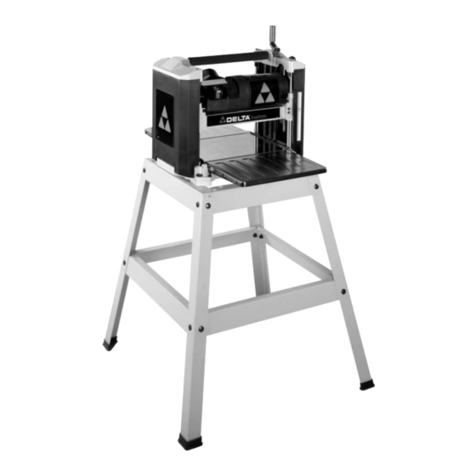
Delta
Delta ShopMaster TP400LS User manual
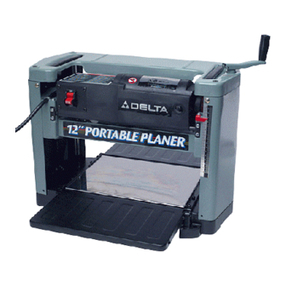
Delta
Delta 22-540 User manual
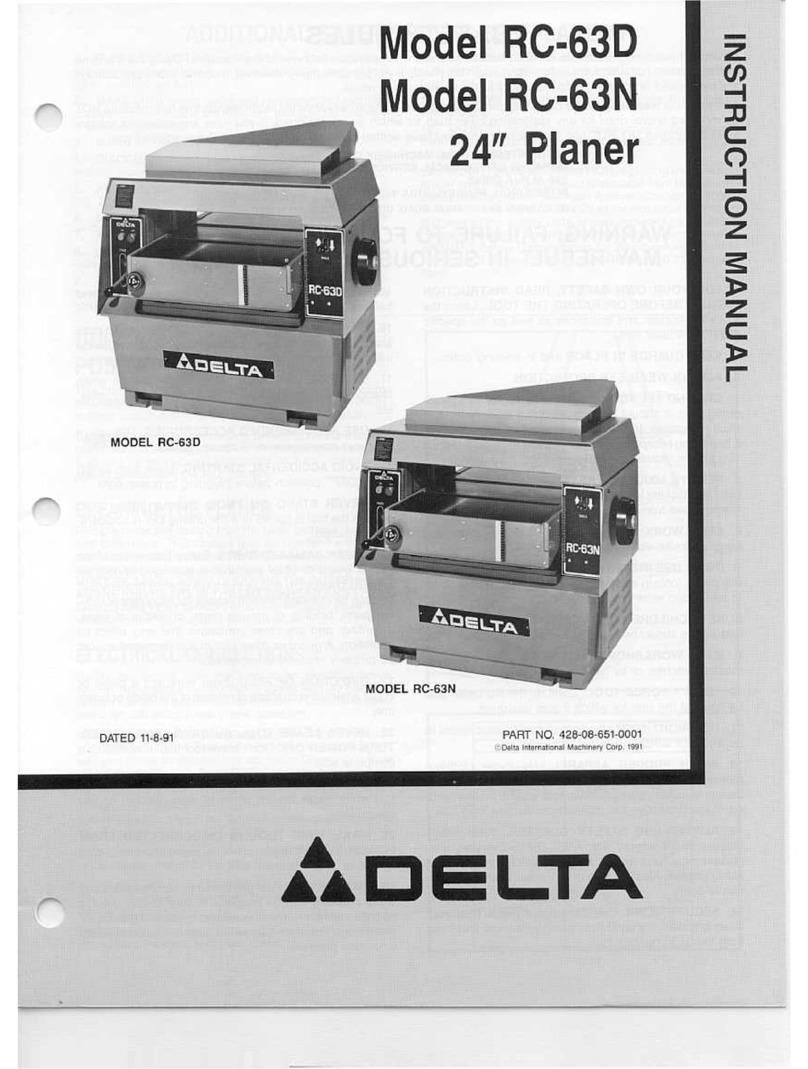
Delta
Delta RC-63D User manual

Delta
Delta RC-51 User manual

Delta
Delta 22-540 User manual
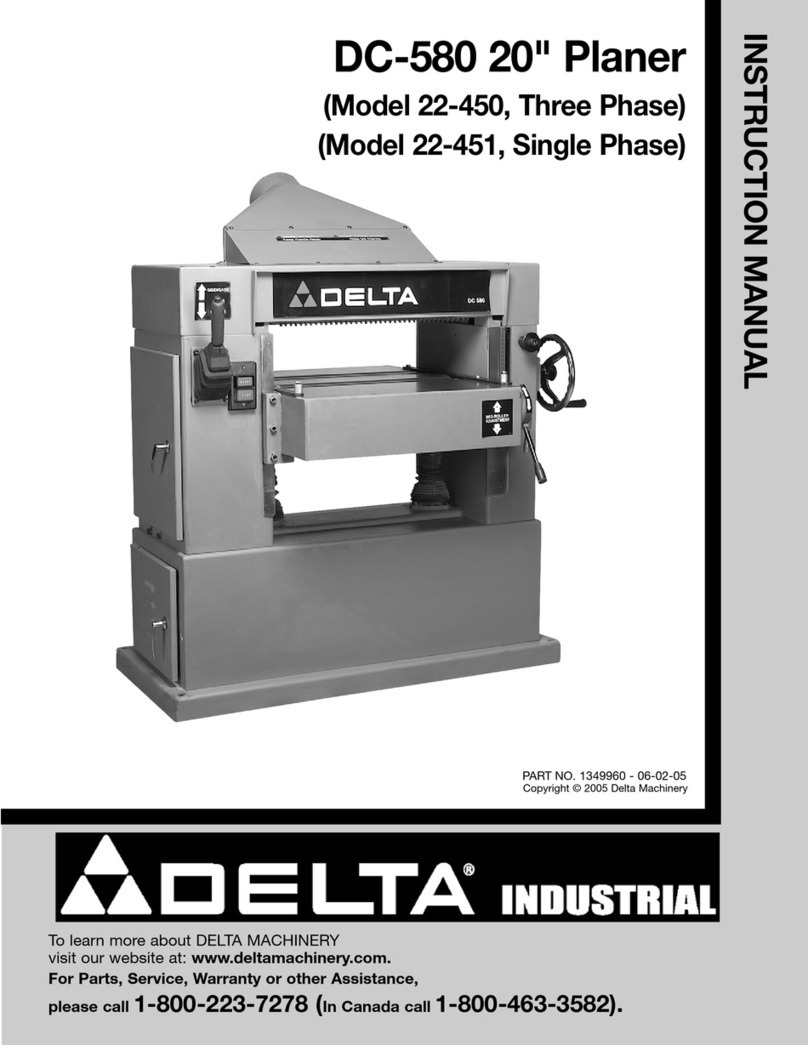
Delta
Delta DC-580 20" PLANER 22-450 User manual

Delta
Delta 22-560 User manual
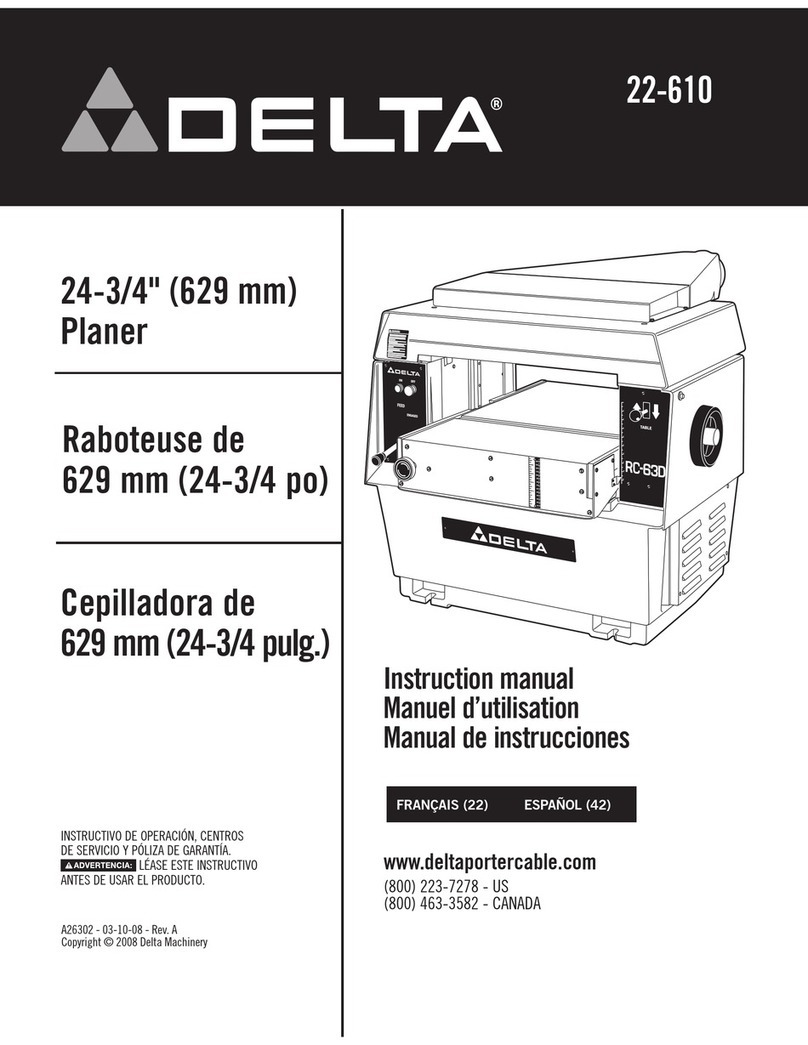
Delta
Delta 22-610 User manual
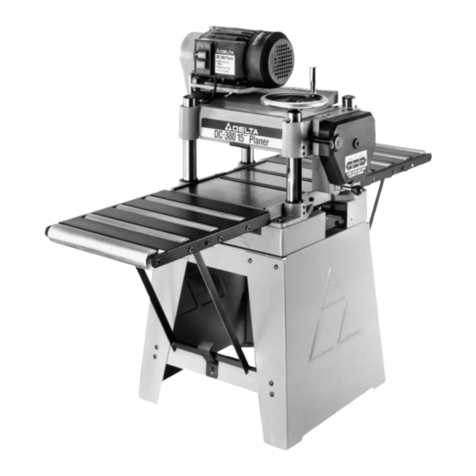
Delta
Delta 22-681 User manual
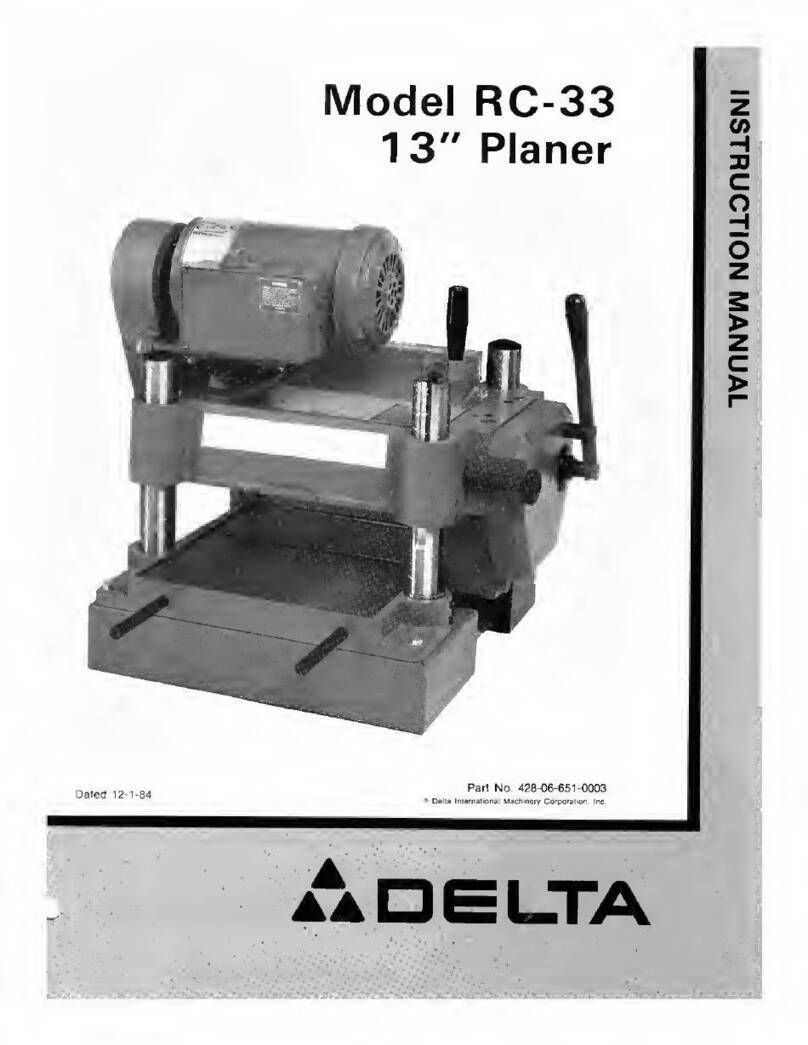
Delta
Delta RC-33 User manual
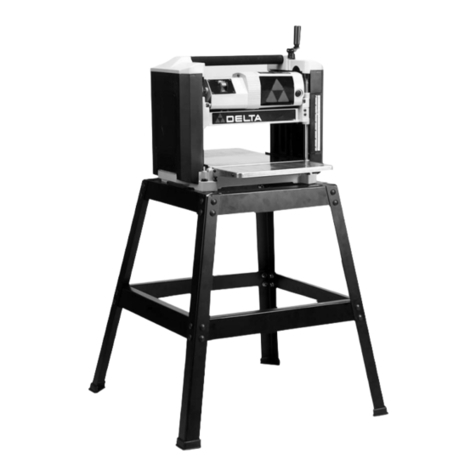
Delta
Delta 22-560 User manual
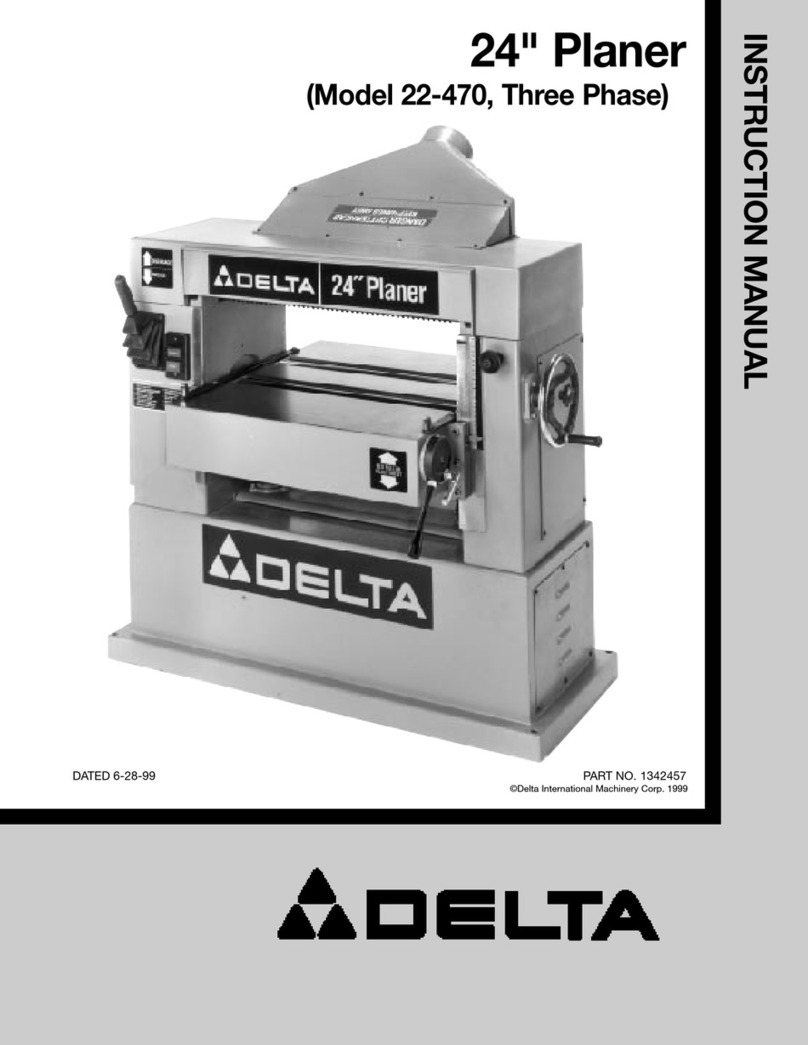
Delta
Delta 22-470 User manual
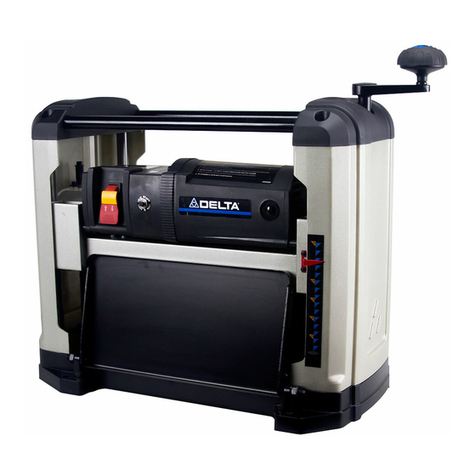
Delta
Delta 22-555 User manual
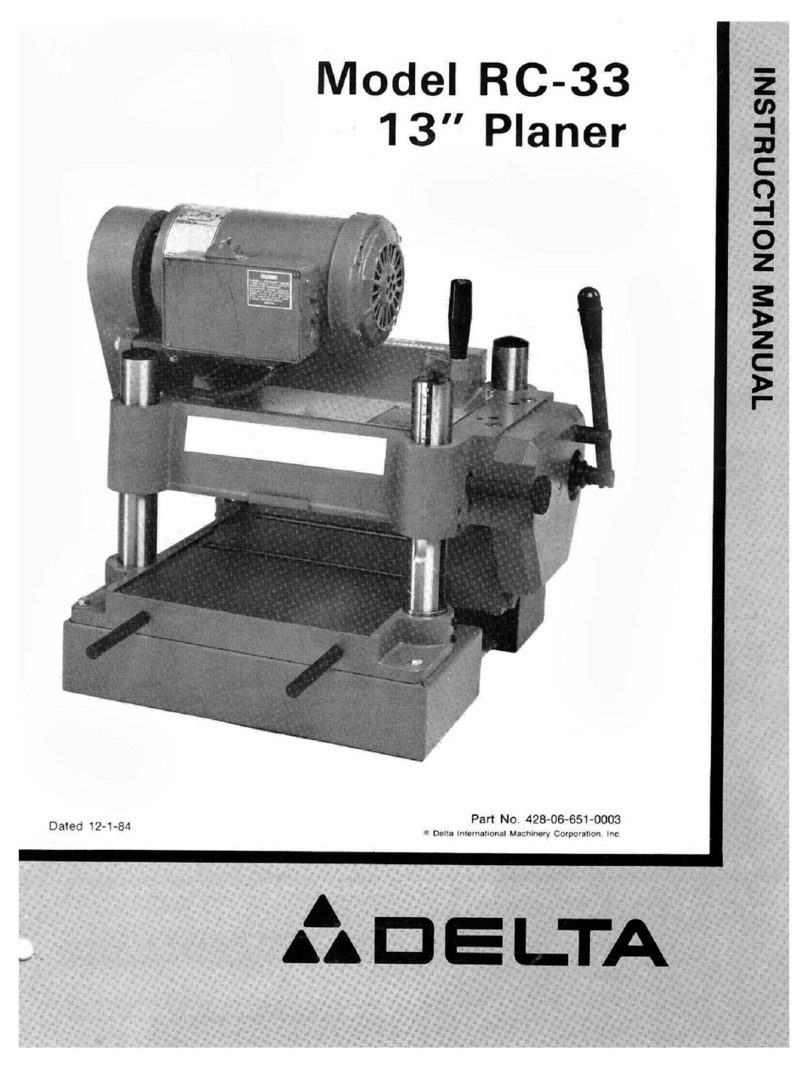
Delta
Delta RC-33 User manual
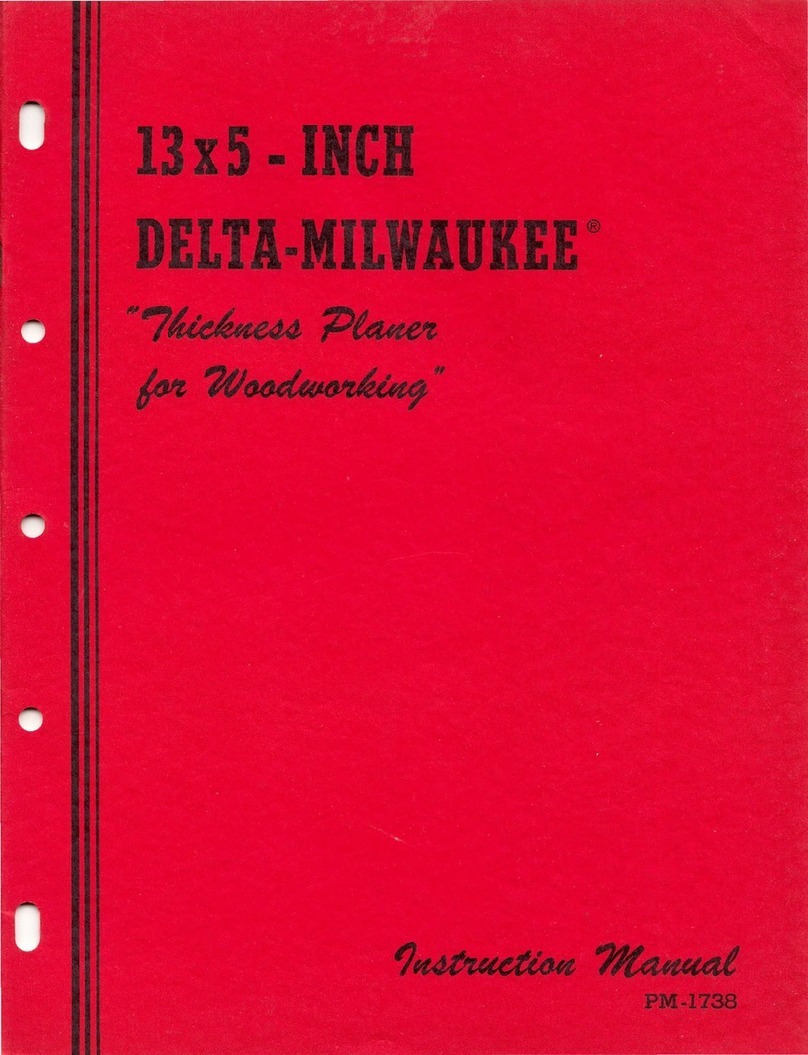
Delta
Delta Milwaukee PM-1738 Manual

Delta
Delta 22-580 User manual

Delta
Delta RC-33 User manual
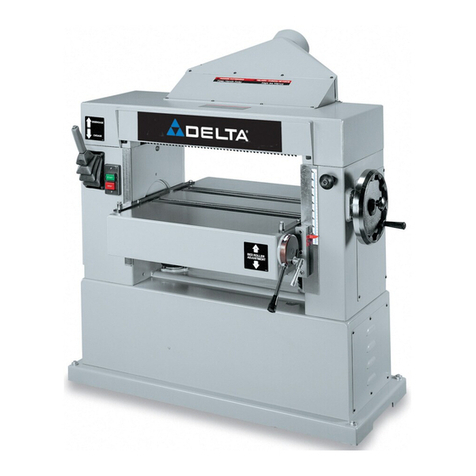
Delta
Delta 22-470 User manual
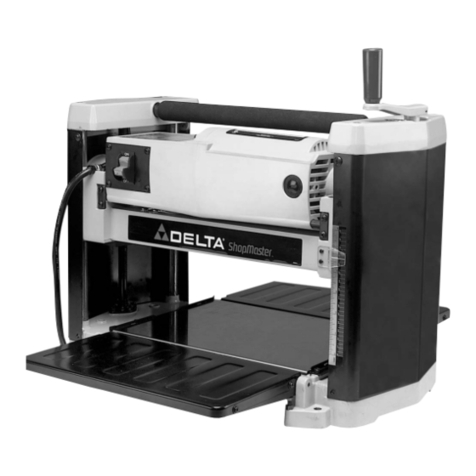
Delta
Delta TP305 User manual
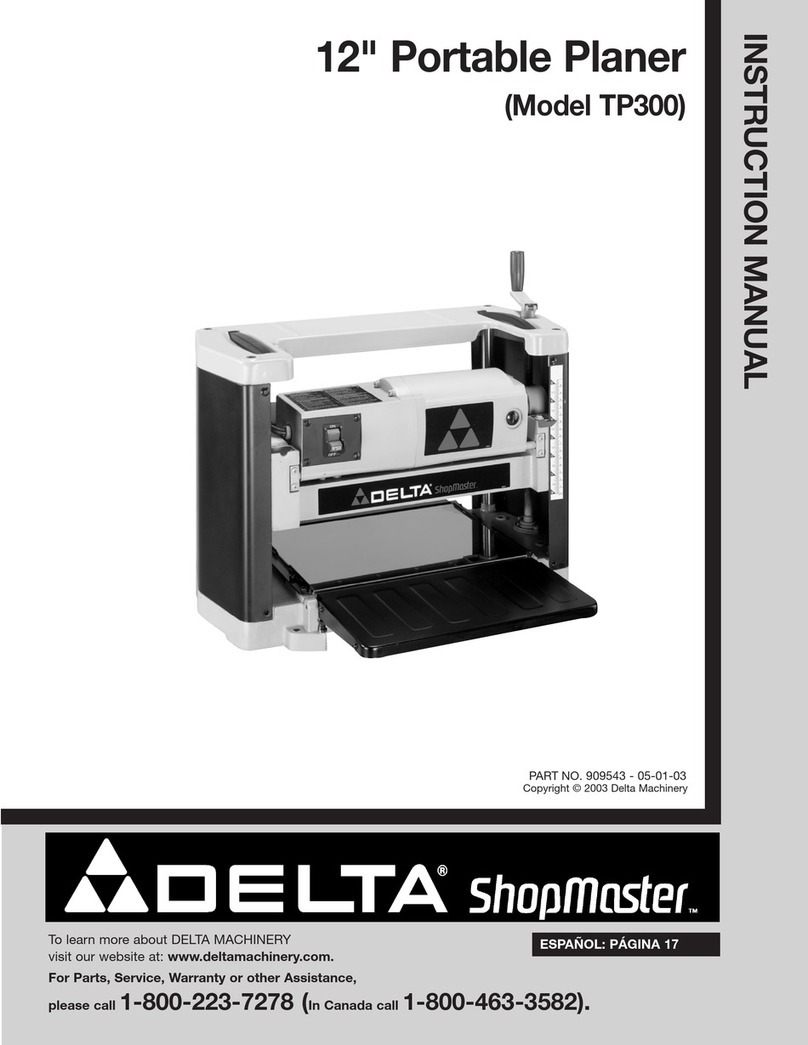
Delta
Delta ShopMaster TP300 User manual
